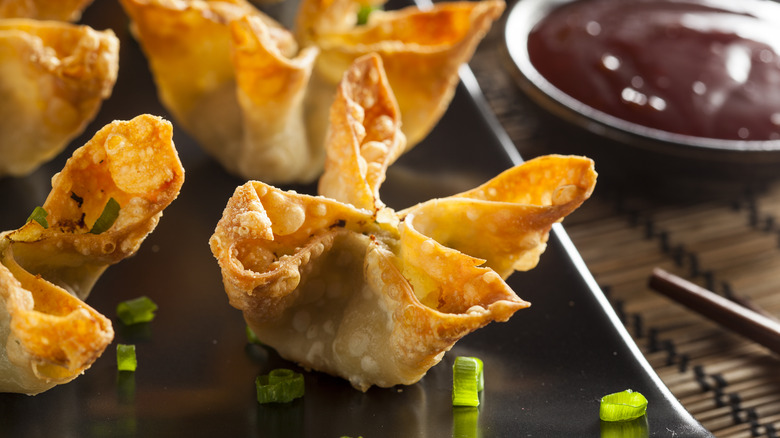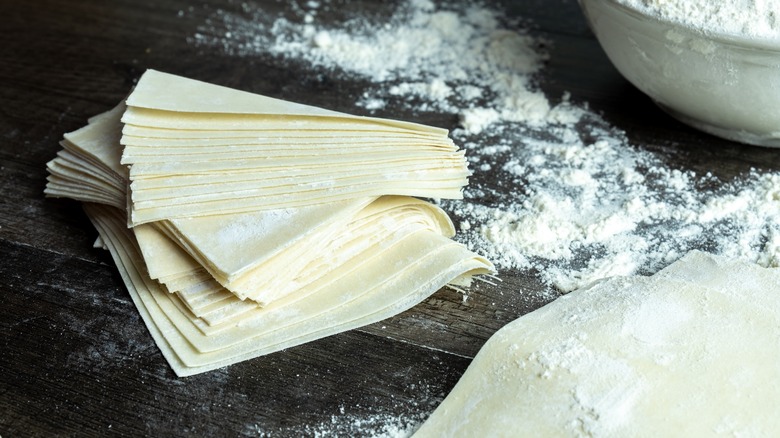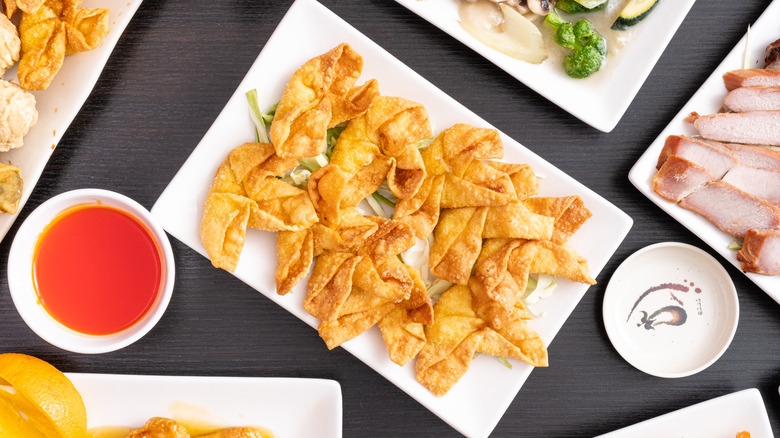The Origin Of Crab Rangoon Goes Further Back Than You'd Think
Crab rangoon has become synonymous with American Chinese cuisine. The inclusion of cream cheese in this creamy, deep-fried pocket clearly indicates its non-Chinese origins, and while it is a beloved staple at chains such as Panda Express and P.F. Chang's, crab rangoon has actually been around much longer than these eateries.
It is believed that these fried, creamy wontons were invented in the 1940s by Victor Bergeron, the founder of Trader Vic's. Bergeron essentially made the dish a part of the tiki culture theme of his bar. Likely, it was the result of Bergeron capitalizing on the popularity of several elements of the time, including the mid-century obsession with cream cheese appetizers, and the country's growing love of American Chinese food. Crab rangoons have remained largely unchanged since their inception — a testament to the fact that, for generations, Americans have had a soft spot for foods that are deep-fried, creamy, salty, sweet, and sour all at once.
Wonton wrappers' popularity played a key role
When Victor Bergeron began serving food at Trader Vic's in 1937, the menu heavily featured American Chinese cuisine, some dishes with a tropical twist to match the restaurant's theme. Eve Bergeron, Victor's granddaughter, suggests the invention of crab rangoon was likely the happy result of her grandfather experimenting with wonton wrappers in the kitchen.
"Knowing my grandfather, he probably just started to play with it," she told Atlas Obscura. "Just put stuff in here, fry it up, and see what we get."
The transition of the dish into mainstream American Chinese restaurants isn't clear, but its overwhelming popularity and the use of wonton wrappers, an inherently Chinese ingredient, likely played a part. Wontons have been part of Chinese cuisine for centuries, mostly enjoyed steamed or in soup. However, when Chinese immigrants came to America in the early 1900s, they found frying oil to be cheap and useful, making fried wontons popular among the masses.
Tiki culture (and therefore Trader Vic's) and American Chinese food both surged in popularity in America around the same time (1940s and 50s). It's not surprising that the two converged in some ways, and this may be how crab rangoon became a part of both worlds.
Updating a classic
If the last 80 or so years have taught us anything about crab rangoon, it's that some dishes are perfect just as they are. While the classic recipe will likely never go out of gastronomical style, there's room for twists. Spicy Cajun crab rangoons combine the original ingredients with sausage, cilantro, and Rotel, while crab rangoon nachos take all the fillings and put them atop fried wonton chips. You could easily turn crab rangoon into a warm dip served with the same chips, or stuff the filling into bread for a decadent grilled cheese sandwich.
To modernize the traditional fried, stuffed pockets that define crab rangoon, consider switching out the cream cheese for something similar in texture, like fresh goat cheese, Boursin, or mascarpone cheese. Mix in some sriracha or chili crisp for spice and texture, or try using tiny pieces of cooked shrimp instead of crab. Don't forget to include a dipping sauce, which is almost always sweet and sour, and typically served with crab rangoon.



